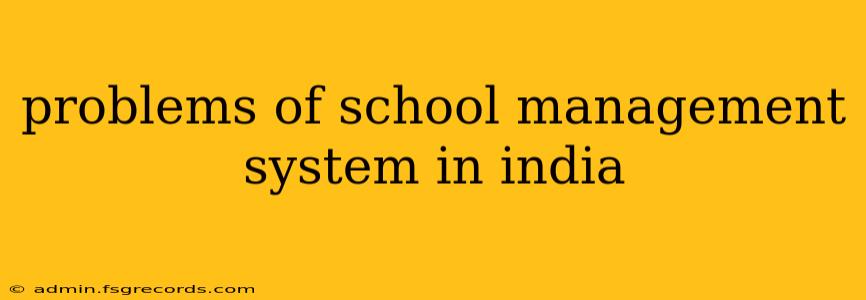India's education system, while making strides, faces significant challenges within its school management systems. These issues impact everything from student learning outcomes to the overall efficiency and equity of the system. This article delves into the multifaceted problems plaguing school management in India, exploring their root causes and potential solutions.
Lack of Technological Integration and Infrastructure
One of the most pervasive problems is the inadequate integration of technology and deficient infrastructure. Many schools, especially in rural areas, lack basic amenities like reliable internet access, computers, and well-equipped labs. This digital divide significantly hinders the adoption of modern school management software and online learning platforms. The absence of robust technological infrastructure hampers effective communication between teachers, parents, and administrators, leading to inefficiencies and a lack of transparency.
Consequences of Technological Deficiency:
- Limited access to educational resources: Students miss out on valuable online learning materials and opportunities for collaborative projects.
- Inefficient administrative processes: Manual record-keeping and data management are time-consuming and prone to errors.
- Communication barriers: Difficulty in disseminating information to parents and stakeholders results in delayed responses to crucial issues.
Inefficient Administrative Processes and Bureaucracy
Complex administrative procedures and bureaucratic hurdles often stifle the effective functioning of schools. Overly centralized decision-making can lead to delays in implementing necessary changes and responding to local needs. The lack of autonomy granted to school principals and teachers can hinder their ability to address specific challenges within their schools.
Consequences of Inefficient Administration:
- Slow response to student needs: Delays in addressing issues like bullying, academic support, or disciplinary problems.
- Ineffective resource allocation: Funds and resources are not always distributed efficiently to where they are most needed.
- Lack of accountability: A lack of clear lines of responsibility can hinder effective monitoring and evaluation of school performance.
Teacher Shortages and Inadequate Training
A chronic shortage of qualified teachers, particularly in specialized subjects and in underserved areas, severely impacts the quality of education. Furthermore, the quality of teacher training often falls short of meeting the demands of a rapidly evolving educational landscape. Many teachers lack access to professional development opportunities, limiting their ability to adopt innovative teaching methods and effectively utilize technology in the classroom.
Consequences of Teacher Shortages and Inadequate Training:
- Increased student-teacher ratios: Leading to less individualized attention for students.
- Lower quality of instruction: Lack of subject matter expertise and effective pedagogical skills.
- Limited capacity for innovation: Inability to implement new teaching strategies and adapt to changing learning needs.
Financial Constraints and Resource Allocation
Inadequate funding is a major constraint for many schools, especially government schools. Limited resources often translate to a lack of essential materials, inadequate infrastructure, and insufficient teacher salaries, leading to high teacher turnover. The inefficient allocation of resources further exacerbates the problem, with some schools receiving disproportionately more funds than others based on factors unrelated to need.
Consequences of Financial Constraints:
- Poor infrastructure: Lack of basic amenities like classrooms, libraries, and sanitation facilities.
- Limited access to learning materials: Students may lack textbooks, stationery, and other essential resources.
- Low teacher morale: Inadequate salaries and poor working conditions contribute to teacher burnout and attrition.
Lack of Parental Involvement and Community Engagement
Effective school management requires strong partnerships between schools, parents, and the wider community. However, in many cases, parental involvement is limited, partly due to factors like low literacy rates, socioeconomic disparities, and a lack of awareness about the importance of school participation. This lack of engagement hampers the school's ability to effectively support student learning and address community-specific needs.
Consequences of Limited Parental Involvement:
- Decreased student achievement: Lack of parental support can negatively impact student motivation and academic performance.
- Limited school accountability: Absence of parental feedback hinders the school's ability to improve its services.
- Weakened school-community relationships: This can limit the school's access to valuable resources and support.
Addressing the Challenges
Overcoming these challenges requires a multi-pronged approach involving increased government funding, improved teacher training, technological advancements, greater parental engagement, and policy reforms to streamline administrative processes and enhance school autonomy. Investing in these areas will be crucial in creating a more effective and equitable education system in India. By addressing these systemic problems, India can significantly improve the quality of education and provide all students with equal opportunities to succeed.

